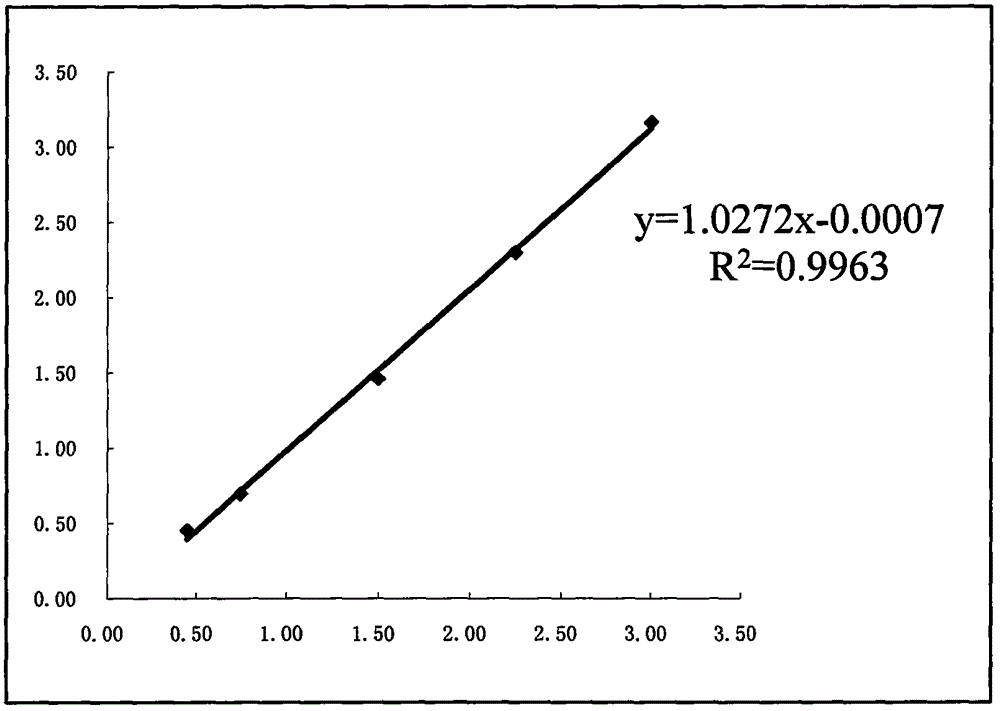Complement C3 detection method
A detection method and complement technology, applied in the biological field, can solve problems such as inaccurate diameter measurement, large variation, and difficult observation of results
- Summary
- Abstract
- Description
- Claims
- Application Information
AI Technical Summary
Problems solved by technology
Method used
Image
Examples
Embodiment
[0013] The method of the present invention is formulated into a kit, and the performance is compared with that of a commercially available kit:
[0014] The concrete composition that reagent of the present invention is made into kit is as follows:
[0015]
[0016]
[0017] Use of complement C3 detection reagents:
[0018] 1) Detection instrument: a biochemical analyzer with a wavelength of 340nm and a constant temperature device at 37°C.
[0019] 2) Sample to be tested: fresh non-hemolyzed serum, stable for seven days at 2-8°C. It can be stable for one month at -20°C.
[0020] 3) Specific testing procedures:
[0021]
[0022] 4) Calculation result: complement C3 concentration (g / L) = ΔAT / ΔAS × Cs
[0023] ΔAT: Absorbance of sample tube
[0024] ΔAS: Calibration tube absorbance
[0025] Cs: calibrator concentration value
[0026] 5) Reference value range: 0.9~1.5g / L
[0027] 6) Precision: intra-assay CV≤4%; inter-assay relative range ≤6%.
[0028] 7) Accuracy...
example 1
[0041] Example 1 Reagent of the present invention compares with the performance index of commercially available reagent A:
[0042] 1) Determination of precision: 20 consecutive samples were taken for measurement, and the mean, standard deviation and coefficient of variation of the measured values were calculated. CV = SD X ‾ × 100 %
[0043] Table 1 Precision test results
[0044]
[0045]
[0046] The coefficient of variation CV is usually used to measure the precision of a determination method, the smaller the CV value, the better the precision of the result of the determination method. For clinical chemistry tests, a method precision with a CV of less than 5% is generally accepted as acceptable. The CV value of the reagent of the present invention in Table 1 is less than that of commercially available reagent A, showing that the precision of t...
example 2
[0051] Example 2 Reagent of the present invention is formulated into kit related performance evaluation
[0052] 1) Determination of precision: 20 consecutive samples were taken for measurement, and the mean, standard deviation and coefficient of variation of the measured values were calculated. CV = SD X ‾ × 100 %
[0053] Table 3 precision test results
[0054]
[0055]
[0056] The coefficient of variation CV is usually used to measure the precision of a determination method, the smaller the CV value, the better the precision of the result of the determination method. For clinical chemistry tests, a method precision with a CV of less than 5% is generally accepted as acceptable. The CV value in Table 3 is less than 3%, indicating that the method of the present invention has excellent precision.
[0057] 2) Measurement of accuracy: use the same ...
PUM
| Property | Measurement | Unit |
|---|---|---|
| particle diameter | aaaaa | aaaaa |
| correlation coefficient | aaaaa | aaaaa |
Abstract
Description
Claims
Application Information
 Login to View More
Login to View More - R&D
- Intellectual Property
- Life Sciences
- Materials
- Tech Scout
- Unparalleled Data Quality
- Higher Quality Content
- 60% Fewer Hallucinations
Browse by: Latest US Patents, China's latest patents, Technical Efficacy Thesaurus, Application Domain, Technology Topic, Popular Technical Reports.
© 2025 PatSnap. All rights reserved.Legal|Privacy policy|Modern Slavery Act Transparency Statement|Sitemap|About US| Contact US: help@patsnap.com



